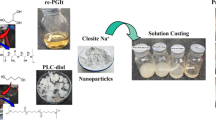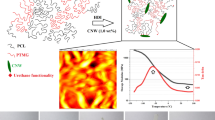Abstract
We report synthesis and characterization of a set of thermoset polyurethane (PU) bionanocomposites based on a polyol blend of poly(ε-caprolactone)/ polyethylene glycol (PCL/PEG) ABA block copolymers and their homopolymers (Mw: 2000 D). ABA block copolymers of PCL/PEG, with variable block lengths, were blended with their homopolymers. The relative weight content of Homo: Block (HB) was set 1:1 and the blend was used to synthesize a PU bionanocomposite using HDI and cellulose nanowhisker (CNW). The change in PEG and PCL block lengths resulted in an extensive change in the crystallization of the soft domains. The results of dynamic and thermal analysis revealed an increasing trend in the crystallization of the PCL/PEG segments as their lengths increase in the block copolymer structure. The shape memory analysis of the PU specimens showed high recovery (84-100%) and fixity (93-100%) ratios. Specimens with about one-order of magnitude fall in the storage modulus in the plateau region showed the highest fixity ratios. The relatively stable storage modulus at the elevated temperature indicate lack of flow for the PU nanocomposites and their thermoset nature. The cytotoxity analysis of the specimens showed a great cytocompatibility, indicating their great potential in the field of tissue engineering as a new biomaterial model. HB6 was selected as the optimum sample with SR and SF of 100%, with the highest cell viability.








Similar content being viewed by others
Data availability
The research data will be provided by the authors upon reasonable request.
References
Shahrousvand M, Mir Mohamad Sadeghi G, Salimi A, Nourany M (2018) Bulk Synthesis of Monodisperse and Highly Biocompatible Poly (ɛ-caprolactone)-diol by Transesterification Side-Reactions. Polym Plast Technol Eng 57(6):492–499
Faÿ F, Linossier I, Langlois V, Renard E, Vallée-Réhel K (2006) Degradation and controlled release behavior of ε-caprolactone copolymers in biodegradable antifouling coatings. Biomacromol 7(3):851–857
Huang MH, Li S, Coudane J, Vert M (2003) Synthesis and Characterization of Block Copolymers of ε-Caprolactone and dl-Lactide Initiated by Ethylene Glycol or Poly (ethylene glycol). Macromol Chem Phys 204(16):1994–2001
Chiang YW, Hu YY, Li JN, Huang SH, Kuo SW (2015) Trilayered Single Crystals with Epitaxial Growth in Poly (ethylene oxide)-block-poly (ε-caprolactone)-block-poly (l-lactide) Thin Films. Macromolecules 48(23):8526–8533
Avci H, Gergeroglu H (2019) Synergistic effects of plant extracts and polymers on structural and antibacterial properties for wound healing. Polym Bull 76(7):3709–3731
Luo Q, Chen J, Gnanasekar P, Ma X, Qin D, Na H, Zhu J, Yan N (2020) A facile preparation strategy of polycaprolactone (PCL)-based biodegradable polyurethane elastomer with a highly efficient shape memory effect. New J Chem 44(3):658–662
Babaie A, Rezaei M, Sofla RLM (2019) Investigation of the effects of polycaprolactone molecular weight and graphene content on crystallinity, mechanical properties and shape memory behavior of polyurethane/graphene nanocomposites. J Mech Behav Biomed Mater 96:53–68
Lv GL, Li YY, Fei C, Shan ZH, Gan J, Zhao M (2019) Preparation and Characterization of In Situ Nanocomposites of Graphene Nanosheets/Polyurethane. In Key Engineering Materials (Vol. 814, pp. 90-95). Trans Tech Publications Ltd.
Zhu K, Li X, Wang H, Fei G, Li J (2016) Properties and paper sizing application of waterborne polyurethanemicroemulsions: Effects of extender, cross‐linker, and polyol. J Appl Polym Sci 133(25)
Rao L, Zhou H, Li T, Li C, Duan YY (2012) Polyethylene glycol-containing polyurethane hydrogel coatings for improving the biocompatibility of neural electrodes. Acta Biomater 8(6):2233–2242
Jafari S, Nourany M, Zakizadeh M, Taghilou A, Ranjbar HA, Noormohammadi F (2020) The effect of controlled phase separation of PEG/PCL-2000 homopolymer polyols using their PCL500-PEG1000-PCL500 tri-block copolymer and CNCs in the final polyurethane hydrogels on their shape memory behavior. Composites Communications.
Afshari E, Rostami M, Farahmand F (2017) Review on different experimental techniques developed for recording force-deformation behaviour of soft tissues; with a view to surgery simulation applications. J Med Eng Technol 41(4):257–274
Afshari E, Sarkhosh H, Najarian S (2017) A novel tactile probe with medical and surgical applications. Sensor Review.
Najafabadi SAA, Keshvari H, Sarkhosh H, Ashuri M, Tahriri M (2014) Surface modification of castor oil‐based polyurethane by polyacrylic acid graft using a two‐step plasma treatment for biomedical applications. Adv Polym Technol 33(3)
Liu W, Zhao Y, Wang R, Li J, Li J, Luo F, Tan H, Fu Q (2017) Post-Crosslinked Polyurethanes with Excellent Shape Memory Property. Macromol Rapid Commun 38(23):1700450
Maji PK, Guchhait PK, Bhowmick AK (2009) Effect of nanoclays on physico-mechanical properties and adhesion of polyester-based polyurethane nanocomposites: structure–property correlations. J Mater Sci 44(21):5861–5871
Sonnenschein MF, Lysenko Z, Brune DA, Wendt BL, Schrock AK (2005) Enhancing polyurethane properties via soft segment crystallization. Polymer 46(23):10158–10166
Korley LTJ, Pate BD, Thomas EL, Hammond PT (2006) Effect of the degree of soft and hard segment ordering on the morphology and mechanical behavior of semicrystalline segmented polyurethanes. Polymer 47(9):3073–3082
Minecka A, Kaminska E, Tarnacka M, Talik A, Grudzka-Flak I, Wolnica K, Dulski M, Kaminski K, Paluch M (2018) Conformational changes underlying variation in the structural dynamics of materials confined at the nanometric scale. Phys Chem Chem Phys 20(48):30200–30208
Liu Y, Li Y, Yang G, Zheng X, Zhou S (2015) Multi-stimulus-responsive shape-memory polymer nanocomposite network cross-linked by cellulose nanocrystals. ACS Appl Mater Interfaces 7(7):4118–4126
Verma M, Chauhan SS, Dhawan SK, Choudhary V (2017) Graphene nanoplatelets/carbon nanotubes/polyurethane composites as efficient shield against electromagnetic polluting radiations. Compos B Eng 120:118–127
Hu J, Zhang C, Ji F, Li X, Han J, Wu Y (2016) Revealing the morphological architecture of a shape memory polyurethane by simulation. Sci Rep 6(1):1–9
Zeimaran E, Pourshahrestani S, Kadri NA, Kong D, Shirazi SFS, Naveen SV, Murugan SS, Kumaravel TS, Salamatinia B (2019) Self-Healing Polyester Urethane Supramolecular Elastomers Reinforced with Cellulose Nanocrystals for Biomedical Applications. Macromol Biosci 19(10):1900176
Li Z, Li J (2013) Control of hyperbranched structure of polycaprolactone/poly (ethylene glycol) polyurethane block copolymers by glycerol and their hydrogels for potential cell delivery. J Phys Chem B 117(47):14763–14774
Noormohammadi F, Nourany M (2020) Mir Mohamad Sadeghi G, Wang PY, Shahsavarani H (2020) The role of cellulose nanowhiskers in controlling phase segregation, crystallization and thermal stimuli responsiveness in PCL-PEGx-PCL block copolymer-based PU for human tissue engineering applications. Carbohydr. Polym. 252:117219. https://doi.org/10.1016/j.carbpol.2020.117219
Kim JK, Park DJ, Lee MS, Ihn KJ (2001) Synthesis and crystallization behavior of poly (l-lactide)-block-poly (ϵ-caprolactone) copolymer. Polymer 42(17):7429–7441
Zheng Z, Cui Z, Si J, Yu S, Wang Q, Chen W, Turng LS (2019) Modification of 3-D porous hydroxyapatite/thermoplastic polyurethane composite scaffolds for reinforcing interfacial adhesion by polydopamine surface coating. ACS Omega 4(4):6382–6391
Niu Y, Yang L, Wang H, Wang Z (2009) Criteria of process optimization in binary polymer blends with both phase separation and crystallization. Macromolecules 42(20):7623–7626
Zhang X, Wang Z, Muthukumar M, Han CC (2005) Fluctuation-assisted crystallization: in a simultaneous phase separation and crystallization polyolefin blend system. Macromol Rapid Commun 26(16):1285–1288
Wang X, Jian W, Lu H, Lau D, Fu YQ (2019) Modeling strategy for enhanced recovery strength and a tailorable shape transition behavior in shape memory copolymers. Macromolecules 52(16):6045–6054
Yu K, Ge Q, Qi HJ (2014) Reduced time as a unified parameter determining fixity and free recovery of shape memory polymers. Nat Commun 5(1):1–9
Fan J, Li G (2018) High enthalpy storage thermoset network with giant stress and energy output in rubbery state. Nat Commun 9(1):1–8
Saralegi A, Gonzalez ML, Valea A, Eceiza A, Corcuera MA (2014) The role of cellulose nanocrystals in the improvement of the shape-memory properties of castor oil-based segmented thermoplastic polyurethanes. Compos Sci Technol 92:27–33
Ranjbar HA, Nourany M, Mollavali M, Noormohammadi F, Jafari S (2020) Stimuli‐responsive polyurethane bionanocomposites of poly (ethylene glycol)/poly (ε‐caprolactone) and [poly (ε‐caprolactone)‐grafted‐] cellulose nanocrystals. Polym Adv Technol.
Chan BQY, Heng SJW, Liow SS, Zhang K, Loh XJ (2017) Dual-responsive hybrid thermoplastic shape memory polyurethane. Mater Chem Front 1(4):767–779
Zakizadeh M, Nourany M, Javadzadeh M, Wang PY, Shahsavarani H (2021) Analysis of crystallization kinetics and shape memory performance of PEG-PCL/MWCNT based PU nanocomposite for tissue engineering applications. vol. 15. https://doi.org/10.3144/expresspolymlett.2021.36
Acknowledgement
The authors have no conflict of interest and the research work was supported by Amirkabir University of Technology.
Author information
Authors and Affiliations
Contributions
Mohammad Nourany (Conceptualization, data acquisition, analysis and interpretation, writing the original draft), Shadi Ghelichkhani (data acquisition and analysis), Hadi Sarkhosh (Conceptualization, data analysis and validation, writing the original draft), Mehrad Zakizadeh (Data analysis and interpretation, software analysis), Toktam Behrouz (Data analysis and interpretation).
Corresponding author
Additional information
Publisher’s Note
Springer Nature remains neutral with regard to jurisdictional claims in published maps and institutional affiliations.
Rights and permissions
About this article
Cite this article
Nourany, M., Ghelichkhani, S., Sarkhosh, H. et al. The effect of PCL/PEG ABA block lengths on the crystallization of homo/block- based polyurethane/CNW nanocomposites. J Polym Res 28, 14 (2021). https://doi.org/10.1007/s10965-020-02376-y
Received:
Accepted:
Published:
DOI: https://doi.org/10.1007/s10965-020-02376-y




